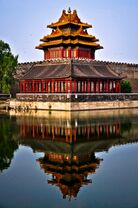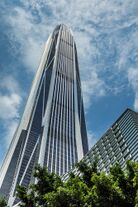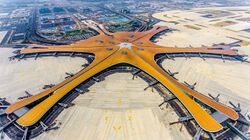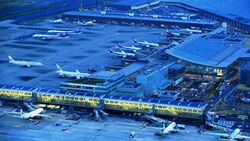Daedo
Daedo | |
|---|---|
Special City | |
| Nickname(s): City of the East, Dragon City, The City | |
| Motto(s): 고요한 아침의 수도 ("Capital of the Morning Calm.") | |
| Country | |
| Special City | Daedo Special City (coterminous) |
| Subdivisions | Districts
|
| Daedo founded | c. 68 AD |
| District Division | Capital District |
| Government | |
| • Type | Daedo Metropolitan Assembly |
| • Elected body | Daedo Metropolitan Assembly |
| • Mayor | Seungjun Jin (N) |
| • Senator | 5 senators |
| Area | |
| • Special City | 6,719.5 km2 (2,594.4 sq mi) |
| • Land | 6,001.3 km2 (2,317.1 sq mi) |
| • Water | 718.2 km2 (277.3 sq mi) |
| Highest elevation | 442.3 m (1,451.1 ft) |
| Lowest elevation | −0.7 m (−2.3 ft) |
| Population (2019) | |
| • Density | 3,217.1/km2 (8,332/sq mi) |
| • Metro | 21,617,281 |
| Demonym | Daedoite/Easterner |
| Time zone | UTC+09:00 (Zhenia Eastern Standard Zone (ZEST)) |
| ZIP Code | 00001-00100 |
| Zhenia Federal Area Code | 02 |
| City Flower | Zhenian Peony |
| Website | www.daedocity.zhen.gov |
Daedo (Classic Zhenian: 大都, Modern Zhenian: 대도, meaning 'Great Capital' in Zhenian), formally Daedo Special City (Classic Zhenian: 大都特別市, Modern Zhenian: 대도특별시), is the capital and most populous city of the Greater Eastern Union of Zhenia. As the only city in the nation administratively designated as a special city, it is governed by the Daedo Metropolitan Government. It faces the Gulf of Danguk to the west and is surrounded by Chungmu Province, while the Danbon River, before emptying into the Gulf of Zhen, passes right through it. Subdivided into 17 districts, it is home to over 21.6 million residents, making it - with parts of the adjacent Chungmu Province - the single largest metropolitan area in the nation.
With historical records detailing its existence dating its origins back to 68 AD, Daedo became the capital of the Jin dynasty in 981, after the royal house relocated from Junggyeong. Although it was burned to the ground by the Kharlin Empire and later faced decline upon the establishment of the Shindan dynasty, Emperor Seongjo declared the city the new capital of the Empire, initiating its age of resurgence. Daedo eventually grew to be the heart of the Greater Eastern Union, rising to be a primary commercial and financial hub in the Asia-Pacific region. The Zhenian reconstruction effort after the Second World War also helped, as Daedo became the core and symbol of Zhenian resurrection during the Third Republic.
Etymology
History
Before the Shindan dynasty
The Shindan dynasty and the Empire of Zhenia
The Greater Eastern Union
Geography
Climate
| Daedo, Zhenia | ||||||||||||||||||||||||||||||||||||||||||||||||||||||||||||
|---|---|---|---|---|---|---|---|---|---|---|---|---|---|---|---|---|---|---|---|---|---|---|---|---|---|---|---|---|---|---|---|---|---|---|---|---|---|---|---|---|---|---|---|---|---|---|---|---|---|---|---|---|---|---|---|---|---|---|---|---|
| Climate chart (explanation) | ||||||||||||||||||||||||||||||||||||||||||||||||||||||||||||
| ||||||||||||||||||||||||||||||||||||||||||||||||||||||||||||
| ||||||||||||||||||||||||||||||||||||||||||||||||||||||||||||
Daedo's climate has a Koppen classification of Cw, indicating a high concentration of yearly precipitation in the summer seasons and generally dry winters, with the regional climate under considerable influence from seasonal winds to the north and south. While spring and fall seasons tend to see lower precipitation, a vast majority of the city's precipitation is focused on June, July and August.
Politics
Federal Government
Metropolitan Government
Administrative Districts
Demographics
History
Religion
Health
Education
Economy
Industry
Trade, Business and Finance
Transport
As both the nation's capital and largest city, transportation in Daedo has been developed with its role as the central hub of not only the Capital Metropolitan Area but also the entirety of the Danguk Peninsula and ultimately Zhenia in mind. As a result, it has some of the most developed transportation networks in the nation via road, rail, air and ultimately shipping. Its public transportation system, particularly its rapid transit network, is one of the largest in the world.
Urban Rail
The Daedo Metro, often stylized as MTX, is the oldest rapid transit line in the nation, with service commencing in 1920. Spanning across over 530 km (329 mi) of track and serving over 3.1 billion riders every year, it is the busiest rapid transit service in the nation and one of the busiest in the world. Situated alongside and beneath MTX lines is the Capital Rapid Express (CRX), an express service connecting the capital city to more distant urban areas without direct MTX coverage, often in neighboring Chungmu Province. Although a vast majority of such lines are operated by the Daedo Capital Transit Authority, other transit corporations, have participated in the operation of select urban rail lines: the Zhenia National Railway Company, for instance, has taken up the operation of the Trans Capital Line, stretching from north to south directly traversing the city.
Buses
Daedo's bus network, operated directly by the Daedo Capital Transit Authority, has four primary types of buses operating throughout the city and vicinity, often complementing the Daedo Metro especially in places without direct rail access. Tied to the Daedo Metro services via an integrated fare system, almost free transfer between Daedo Metro lines and Daedo's bus network is possible, with Daedo buses often directly allowing for free transfers in certain stops in close proximity to metro stations. The designation of bus-only lanes in city center as well as the introduction of bus rapid transit services further connected more distant urban areas to the city center, effectively complementing both the capacity and location-related restrictions of the Daedo Metro. Most bus rapid transit hubs, as well as transfer hubs for urban buses, are located near major Daedo Metro stations.
In addition to the city's urban bus network, Daedo is also the nexus of the nation's intercity bus services, primarily serving the Danguk Peninsula region. Three intercity bus terminals - Daedo South Station, Shinsa Express Bus Terminal and Munmu Intercity Bus Terminal - primarily offer both intercity and express coach services to cities throughout the Danguk Peninsula and beyond.
Air
The city is served by two airports - Daedo Capital International Airport (IATA: DCX), which is the primary international and domestic hub of the city, and Jinpo International Airport, the former international hub of the city before Daedo Capital International Airport and currently the city's secondary hub. Daedo Capital International Airport, primarily serving international and cargo air traffic, opened in 1997, was built upon reclaimed land in the southwestern coastal region of the city to replace Jinpo International Airport as the city's international hub. Situated around 45 kilometers to the southwest of the city center, it is the single largest and busiest international airport in the nation, serving over 100 million passengers in 2018. It serves as the primary hub for Zhenian Airways, Air Zhenia and StarEast Airlines. The Capital Airport Expressway and other highways directly connect the airport to the city, which then links to the city's extensive road network; driving under normal conditions would take 45 minutes from the city center to airport. The Airport Railway and the MTX Blue Line, as well as various airport bus services, serve the airport.
While it is no longer the city's primary international hub, Jinpo International Airport (IATA: JPI) still remains a secondary hub airport complementing Daedo Capital International Airport, retaining most domestic and assorted international flights, as well as business-centered private charter flights. Situated around 32 kilometers to the northwest of city center, it was the city's primary hub airport from 1934 to 1997. Although no longer the primary hub of full service carriers such as Zhenian Airways and Air Zhenia, the airport is still widely used as secondary hubs of Zhenian carriers and leisure airlines. It is connected by the Airport Railway and the MTX Orange Line, as well as various airport and metropolitan bus services.
Domestic flights connecting Daedo and some of the nations's largest cities, particularly Changan, Shinhang, Jinhae, Bakhan and Jin-Nampo, have all come under competition with high-speed rail amid the expansion of the Zhenia National Express (ZNX) since the 1970s, to the degree of most air services within the Danguk Peninsula being almost completely replaced by train services. Although the predominance of flight is expected to persist in routes across the Gulf of Danguk and onto mainland Zhenia, it has been facing sheer competition amid the improvement of express train services of the ZNX.
Road Network
Intercity Rail
Apart from regional rapid transit services, Daedo is served by an array of intercity trains linking the city to various points across the nation. There are four ZNX stations within city limits - Daedo Central Station, Daedo South Station, Daedo North Station and Shin Daedo Station, all four of which are directly linked to one another by ZNX shuttles and MTX services. Other trains, such as the Shinjin Express and the Trans Danguk Railway, directly pass through the city.









